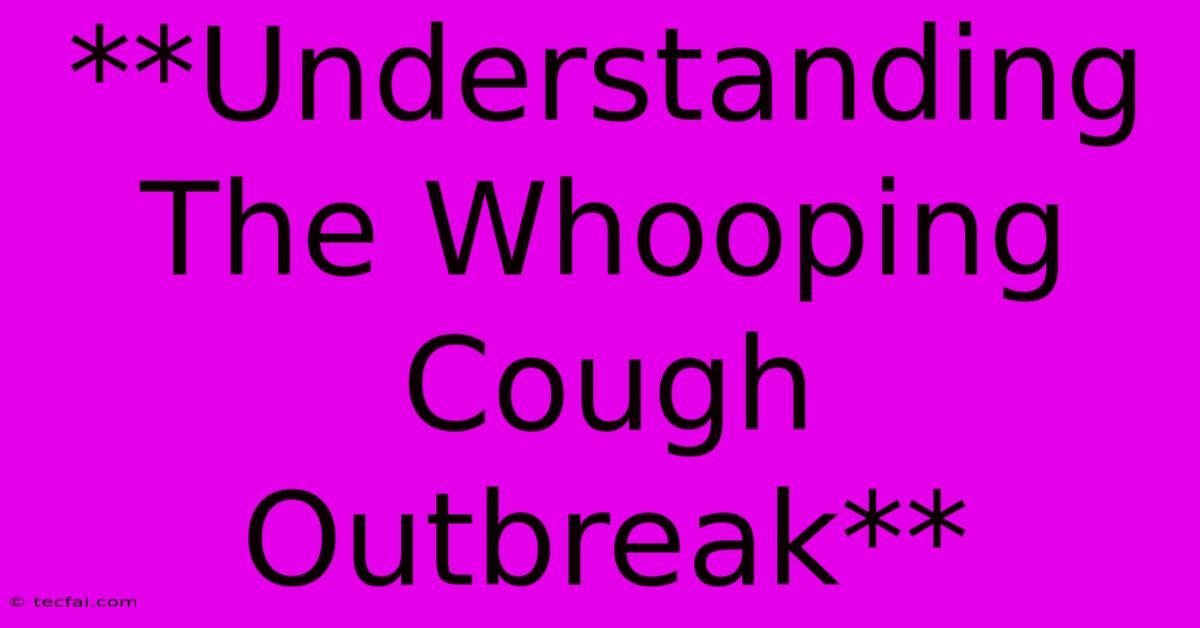**Understanding The Whooping Cough Outbreak**

Discover more detailed and exciting information on our website. Click the link below to start your adventure: Visit Best Website tecfai.com. Don't miss out!
Table of Contents
Understanding The Whooping Cough Outbreak: A Guide to Prevention and Treatment
Whooping cough, also known as pertussis, is a highly contagious respiratory infection that can be serious, especially for infants and young children. While often associated with its distinctive "whooping" cough sound, the disease can present in a variety of ways, leading to potential complications and even death. This article aims to provide a comprehensive understanding of whooping cough, including its causes, symptoms, diagnosis, treatment, and most importantly, how to prevent this potentially dangerous illness.
What is Whooping Cough?
Whooping cough is caused by the bacterium Bordetella pertussis. This bacteria spreads through the air when an infected person coughs or sneezes, releasing tiny droplets that contain the bacteria. These droplets can then be inhaled by others, leading to infection.
Symptoms of Whooping Cough
Whooping cough typically progresses through three stages:
1. Catarrhal Stage: This stage is characterized by mild, cold-like symptoms, such as runny nose, sneezing, low-grade fever, and mild cough. This stage can last for 1-2 weeks.
2. Paroxysmal Stage: This is the most recognizable stage of whooping cough. It features a series of violent coughing fits that can last for several weeks. These fits are often followed by a characteristic "whooping" sound as the person struggles to breathe in air. This stage can also include vomiting, fatigue, and even breathing difficulties.
3. Convalescent Stage: This final stage marks the gradual recovery from whooping cough. The coughing fits become less frequent and less severe, eventually disappearing completely. This stage can last for several weeks or even months.
Diagnosis of Whooping Cough
Diagnosis of whooping cough is typically made based on the patient's symptoms and a physical examination. However, laboratory tests, such as a nasal swab, can be used to confirm the presence of Bordetella pertussis bacteria.
Treatment of Whooping Cough
Antibiotics are the primary treatment for whooping cough. They can help to reduce the severity and duration of the illness and also prevent its spread. However, it's important to note that antibiotics are most effective in the early stages of the disease, before the coughing fits become severe.
Prevention of Whooping Cough
Vaccination is the most effective way to prevent whooping cough. The pertussis vaccine is a safe and effective way to protect individuals from this serious infection. The vaccine is typically given as part of the DTaP (diphtheria, tetanus, and pertussis) or Tdap (tetanus, diphtheria, and pertussis) series.
Who is at Risk?
Infants, young children, and people with weakened immune systems are at the highest risk for serious complications from whooping cough. It is crucial to ensure that infants and young children are fully vaccinated against pertussis.
Conclusion
Whooping cough is a serious disease that can have devastating consequences. Understanding its causes, symptoms, diagnosis, and treatment is essential for protecting individuals, especially vulnerable populations, from this highly contagious infection. By practicing proper hygiene, staying up-to-date on vaccinations, and seeking prompt medical attention when necessary, we can significantly reduce the risk of this preventable disease.

Thank you for visiting our website wich cover about **Understanding The Whooping Cough Outbreak**. We hope the information provided has been useful to you. Feel free to contact us if you have any questions or need further assistance. See you next time and dont miss to bookmark.
Featured Posts
-
Edwards Stars Timberwolves Top Bulls 135 129
Nov 08, 2024
-
Jets Salvage Point In 2 2 Tie
Nov 08, 2024
-
Herbstreit Shares Emotional Post On Dog Bens Death
Nov 08, 2024
-
Outer Banks Season 4 Unexpected Star Shines
Nov 08, 2024
-
Bank Of England Interest Rates Live Updates
Nov 08, 2024
